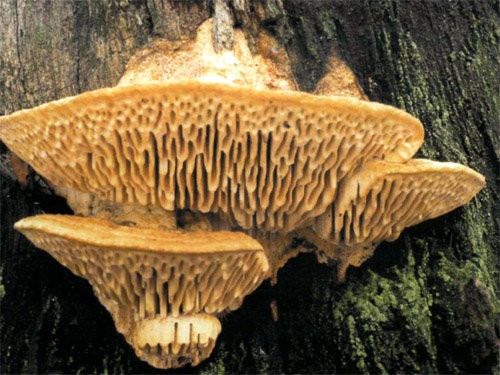Oak Sponge (Daedalea quercina)
- Division: Basidiomycota (Basidiomycetes)
- Subdivision: Agaricomycotina (Agaricomycetes)
- Class: Agaricomycetes (Agaricomycetes)
- Subclass: Incertae sedis (of uncertain position)
- Order: Polyporales (Polypore)
- Family: Fomitopsidaceae (Fomitopsis)
- Genus: Daedalea (Dedalea)
- Type: Daedalea quercina (Oak Sponge)

Hat:
The Oak Sponge’s hat grows to an impressive size. Its diameter can reach ten to twenty centimeters. The hat is hoof-shaped. The upper side of the cap is painted in white-gray or light brown. The surface of the cap is uneven, there is an external, prominent thin edging. The cap is bumpy and rough, with concentric woody grooves.
Pulp:
the flesh of the Oak Sponge is very thin, corky.
Tubular layer:
the tubular layer of the fungus grows up to several centimeters thick. The pores, barely visible, are visible only along the edges of the cap. Painted in pale wood color.
Spread:
Oak Sponge is predominantly found on oak trunks. Sometimes, but rarely, it can be found on the trunks of chestnuts or poplars. Fruits all year round. The fungus grows to enormous size and grows for several years. The fungus is distributed in all hemispheres, is considered the most common species. It grows wherever there are suitable conditions. Very rare on living trees. The fungus causes the formation of heartwood brown rot. Rot is located in the lower part of the trunk and rises to a height of 1-3 meters, sometimes it can rise up to nine meters. In forest stands, the Oak Sponge does little harm. This fungus causes more damage when storing cut wood in warehouses, buildings and structures.
Similarity:
Oak Sponge in appearance strongly resembles the same inedible mushroom – Tinder fungus. It is distinguished by the fact that the thin fruit bodies of Trutovik turn red when fresh when pressed. The fungus is easy to recognize due to the characteristic place of growth (dead and living branches and stumps of oak), as well as the special, labyrinth-like structure of the tubular layer.
Edibility:
the mushroom is not considered a poisonous species, but is not eaten because it has an unpleasant taste.









